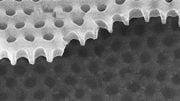
Researchers show that atomically thin graphene layers can efficiently manipulate THz electromagnetic waves, enabling the development of compact and cost-effective devices operating in the THz band.
Future communication devices may get a big boost in efficiency from terahertz waves and graphene. In a newly published study, scientists at the University of Notre Dame have shown that it is possible to manipulate THz electromagnetic waves with thin layers of graphene.
People use electromagnetic energy every day … watching television, listening to the radio, popping corn with a microwave, taking an X-ray or using a cellphone. This energy travels in the form of waves, which are widely used in electronic and wireless devices.
One of the hottest areas of the electromagnetic spectrum being explored today is the terahertz (THz) range. Terahertz waves, lying between microwave and optical frequencies, offer improved performance for a variety of applications in everyday life. For instance, THz waves can carry more information than radio/microwaves for communications devices. They also provide medical and biological images with higher resolution than microwaves, while offering much smaller potential harm of exposure than X-rays.
Researchers at the University of Notre Dame have shown that it is possible to efficiently manipulate THz electromagnetic waves with atomically thin graphene layers. This achievement, which was recently published in the journal Nature Communications, sets the stage for development of compact, efficient, and cost-effective devices and systems operating in the THz band.
“A major bottleneck in the promise of THz technology has been the lack of efficient materials and devices that manipulate these energy waves,” says Berardi Sensale-Rodriguez, a graduate student in the Department of Electrical Engineering at Notre Dame. “Having a naturally two-dimensional material with strong and tunable response to THz waves — for example, graphene — gives us the opportunity to design THz devices achieving unprecedented performance.”
The terahertz team — graduate students Sensale-Rodriguez, Rusen Yan, Kristof Tahy and Tian Fang; research assistant professors Michelle M. Kelly, through Center for Nano Science and Technology (NDnano), and Lei Liu, in conjunction with Advanced Diagnostics and Therapeutics at Notre Dame (AD&T); visiting research assistant professor Wan Sik Hwang, with Midwest Institute for Nanoelectronics Discovery (MIND); associate professor Debdeep Jena and John Cardinal O’Hara, C.S.C., Associate Professor Huili (Grace) Xing — has demonstrated the first proof of concept prototype of a graphene-based THz modulator, a device enabled solely by intraband transitions in graphene.
Graphene, an atom-thick semiconductor material, has shown promising electrical, mechanical, and thermal properties leading to the recent demonstration of fast transistors, flexible/transparent electronics, optical devices, and now terahertz active components.
“Graphene has been touted as an ideal platform to discover new, as well as prove/dispute existing, physical phenomena since 2004,” Xing said. “That is what two physicists in the United Kingdom, Andre Geim and Konstantin Novoselov, were awarded the Nobel Prize for in 2010. However, very few real-world applications of graphene have emerged to date. Using graphene to manipulate THz waves is one of such applications. This Nature Communication paper documented our first experimental effort to realize the predictions in our paper published in Applied Physics Letters last year. Devices with better performance continue rolling out of our laboratories.
“Though Professor Jena and I formed the vision to use two-dimensional electron gas to manipulate THz waves back in 2006, it was not until Michelle, Lei, and Berardi joined us that this piece of work was possible,” Xing added.
Reference: “Broadband graphene terahertz modulators enabled by intraband transitions” by Berardi Sensale-Rodriguez, Rusen Yan, Michelle M. Kelly, Tian Fang, Kristof Tahy, Wan Sik Hwang, Debdeep Jena, Lei Liu and Huili Grace Xing, 17 April 2012, Nature Communications.
DOI: 10.1038/ncomms1787
This research was supported by the National Science Foundation and the Office of Naval Research, as well MIND, NDnano and AD&T.









Be the first to comment on "Exploring Graphene-Based THz Devices"